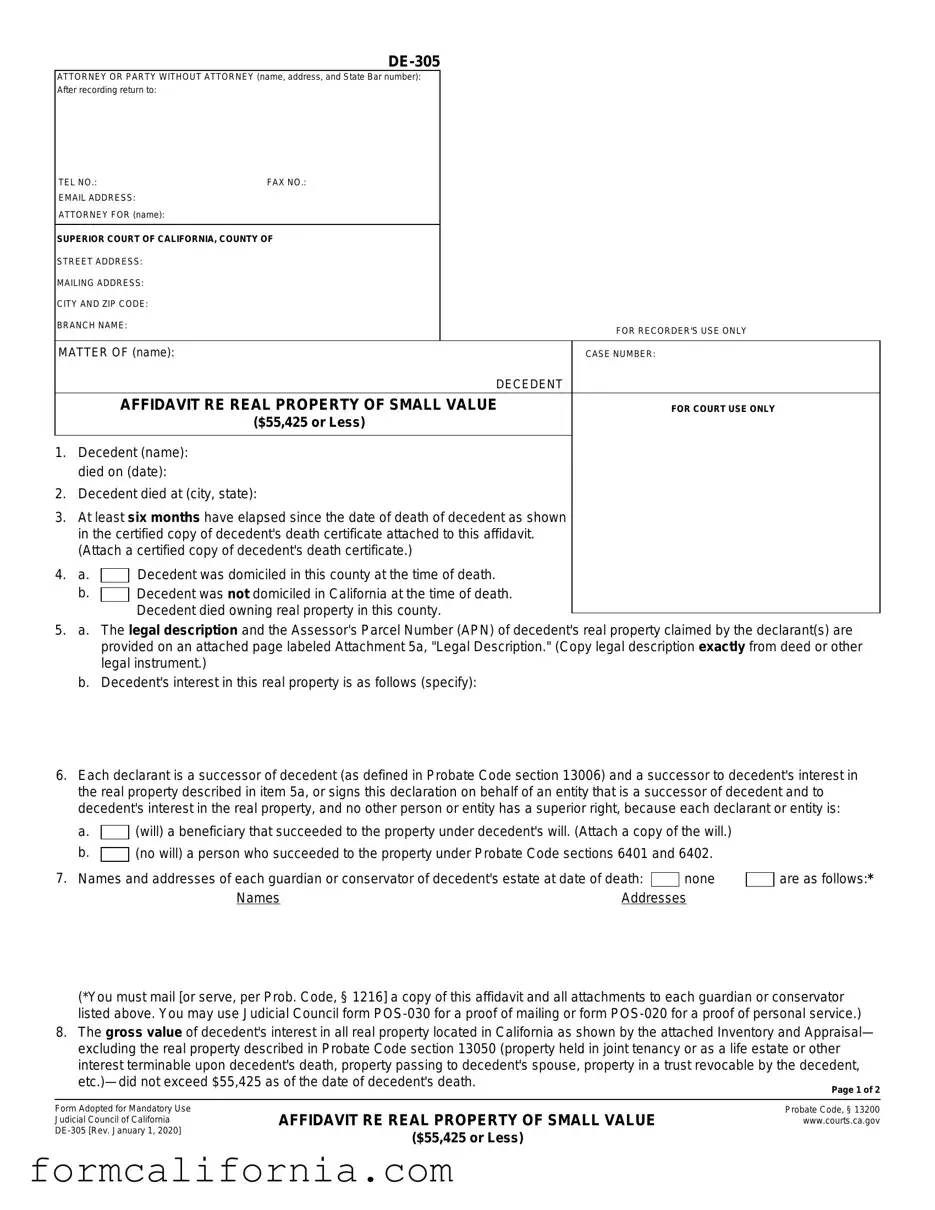The California DE-305 Affidavit re Real Property of Small Value shares similarities with the Affidavit for Collection of Personal Property, also known under California Probate Code Section 13100. Both documents allow successors to claim property without a formal probate process, but the DE-305 specifically addresses real property with a value below a certain threshold, whereas the Affidavit for Collection of Personal Property pertains to personal property. Both require the declarant to affirm their succession rights and that no other superior claims exist, streamlining the inheritance process for smaller estates.
Another document resembling the DE-305 form is the Small Estate Affidavit used in other jurisdictions for transferring assets without probate. Similar to California's DE-305, these affidavits serve to expedite the asset transfer process for estates below a specific value. However, the value threshold and the types of assets that can be transferred vary by state. The key likeness lies in the purpose: both aim to simplify the legal procedures necessary for transferring assets of smaller estates.
The Petition to Determine Succession to Real Property is akin to the DE-305 form in its function within estate management, particularly under California Probate Code sections 13150 to 13158. While the DE-305 affidavit facilitates the transfer of real property from decedents with estates valued below $55,425, the Petition for Succession involves a court process for property valued above this amount but below a higher threshold, requiring judicial confirmation of the transfer.
Transfer on Death Deeds (TODDs), authorized in many states including California, also share objectives with the DE-305 form, though they operate differently. TODDs allow property owners to designate beneficiaries for their real estate, effective upon the owner’s death, bypassing probate. Both methods aim to simplify the transfer of property upon death, but while the DE-305 is used posthumously and for small-value estates, TODDs are prepared in advance by the property owner.
The DE-305 form is similar to the Spousal (or Domestic Partner) Property Petition in that both are used to expedite the property transfer process upon a decedent's death, within California’s legal framework. The Spousal Property Petition specifically facilitates the transfer of property to a surviving spouse or domestic partner, possibly including both community and separate property. The primary similarity is the bypassing of traditional, lengthy probate proceedings.
A life estate deed, which allows a property owner to transfer their property while retaining the right to occupy it for life, shares a conceptual resemblance to the motives behind the DE-305 form. Both approaches involve planning for the eventual transfer of real property upon death without the need for probate. However, a life estate deed is proactive, while the DE-305 is reactive, applying after the property owner’s death.
The Trust Certification is another document related to the DE-305, as both involve estate planning and asset transfer without court intervention. A Trust Certification certifies the trustees' authority to act on behalf of the trust, facilitating asset transfers into or out of the trust without revealing the full trust document. Though differing in application, both forms streamline the process of transferring assets, reducing the need for formal probate.
The Joint Tenancy Grant Deed, used to create joint tenancy ownership with the right of survivorship, offers a parallel to the DE-305's purpose. Upon one owner’s death, the property immediately transfers to the surviving owner(s) without probate. While the DE-305 allows for the transfer of real property after death in small estates, a joint tenancy deed prevents the need for such a document by automatically transferring ownership.
Last, the General Assignment of Assets is akin to the DE-305 as it pertains to the transfer of asset ownership. While the General Assignment may be used within living trusts to transfer personal property into a trust, the DE-305 specifically relates to the posthumous transfer of real property under a defined value without probate. Both documents facilitate smoother transitions of ownership but differ in their specific uses and the types of assets they address.



 Decedent was domiciled in this county at the time of death.
Decedent was domiciled in this county at the time of death. Decedent was
Decedent was  (
( (
(